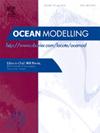A regional NEMO 4.0 configuration of the subpolar North Atlantic
IF 3.1
3区 地球科学
Q2 METEOROLOGY & ATMOSPHERIC SCIENCES
引用次数: 0
Abstract
The dynamics of the North Atlantic subpolar gyre (SPG) largely control the Atlantic Meridional Overturning Circulation (AMOC), thus affecting the long-term climate variability of the global ocean. Many key processes in the North Atlantic SPG, such as Gulf Stream detachment, eddy activity, deep convection and overflows, are frequently incorrectly presented or misrepresented in modern ocean general circulation models. Here, we demonstrate a new regional eddy-resolving model of the subpolar North Atlantic based on the NEMO4 configuration and analyze its ability to adequately represent the dynamics of the subpolar North Atlantic. The model performance is assessed using in situ data (cross-section hydrography, Argo and sea gliders), remote sensing data (satellite sea surface temperature and salinity) and the ANDRO and ARMOR3D products based on optimal interpolation products. In the next step, we analyze the effects of several recent developments in ocean modeling to improve the model solution. The implementation of the self-diffusive momentum advection scheme with additional viscosity allows for the simulation of more realistic Deep Western Boundary Current and Irminger Rings lifecycle characteristics. The surface current feedback parameterization implemented in the forcing function and the modification of the kinetic energy budget in the upper ocean, especially in intensively eddying areas, simulate the behavior predicted by coupled models. While the model is sensitive to the implementation of cool skin–warm layer parameterization, this parameterization does not significantly improve the solution compared to the observational data. Regional implementation of the local-sigma vertical coordinate system in cascading areas allows overflow waters to spread over the ocean bottom more realistically. The remote effect of the implementation of the local-sigma coordinate is traced in the vertical thermohaline structure at the western slopes of the Irminger Sea and Iceland Basin as well as in the Deep Western Boundary Current in the Labrador Sea. Compared to z-partial step setting, local-sigma allows for correct representation of continuous densification of the water in the overturning part of the AMOC and thus North Atlantic Deep Water formation. The potential of the new model configuration for analyzing the subpolar North Atlantic, including convective activity, is discussed.
求助全文
约1分钟内获得全文
求助全文
来源期刊

Ocean Modelling
地学-海洋学
CiteScore
5.50
自引率
9.40%
发文量
86
审稿时长
19.6 weeks
期刊介绍:
The main objective of Ocean Modelling is to provide rapid communication between those interested in ocean modelling, whether through direct observation, or through analytical, numerical or laboratory models, and including interactions between physical and biogeochemical or biological phenomena. Because of the intimate links between ocean and atmosphere, involvement of scientists interested in influences of either medium on the other is welcome. The journal has a wide scope and includes ocean-atmosphere interaction in various forms as well as pure ocean results. In addition to primary peer-reviewed papers, the journal provides review papers, preliminary communications, and discussions.
 求助内容:
求助内容: 应助结果提醒方式:
应助结果提醒方式:


